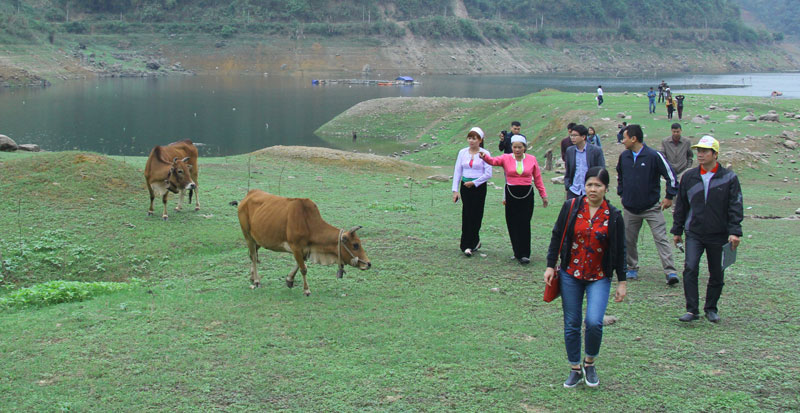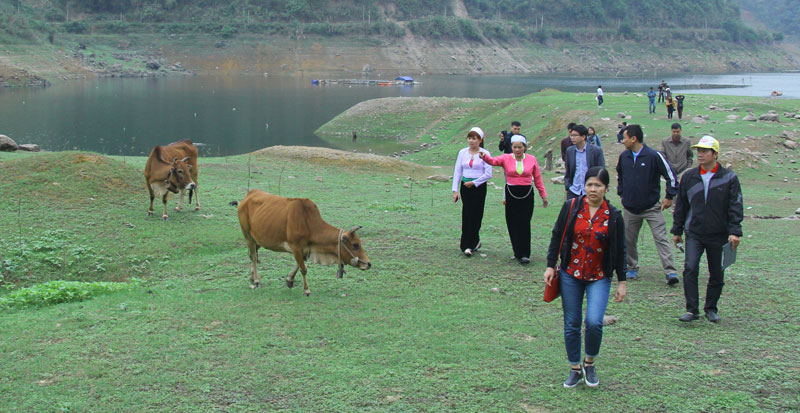
(HBO) – Ke hamlet in Hien Luong commune, Da Bac district, the northern mountainous province of HoaBinh, is an ideal destination in Hoa Binh lake area for visitors who wish to explore nature and culture.
Tourists
can reach Ke hamlet, which is located along Hoa Binh lake with 80 Muong
households, via waterways and roads. It takes about 15 minutes to walk from the
centre of Da Bac town to Hien Luong commune. Tourists can also depart from Bich
Ha Port in Hoa Binh city and travel around Hoa Binh lake for an hour before
reaching Ke hamlet.

Visitors
will cross a grass cover along the lake on the way to Ke hamlet, Hien Luong
commune (Da Bac district) by water.
Two
families in Ke hamlet, including HuuThao’s and Sanh Thuan’s, offer home-stay
services. Three more households will provide the service soon. The local
landscape, culture and people have attracted visitors near and far, as
reflected through the increasing number of holiday-makers. Apart from
international tourists and local students, Ke hamlet also welcomes families.
Visitors will have a chance to explore mountains, imposing forests and vast
lakes in Ke hamlet, and live with locals.
Home-stay
service suppliers and locals will guide tourists on how to discover Ke hamlet.
Holiday makers should base on their vacation length to
arrange the activities they want to do on their own ways when staying in the
locality. They can row, swim in lakes or streams, ride bikes and walk in the
jungle, or join locals in harvesting rice, fishing, hunting and weaving. They
can also go with locals into the jungle to dig bamboo shoots, which can be
boiled, roasted or used to make soup. Fishing and taking a view of the lake
during moonlit nights is the enjoyable experience. The lake is rich in shrimp
and fish, from African carp to carp, chub, pike, and even trionychid turtle.
Tourists can catch crabs and fish
while bathing in Ke Spring. Other local specialties are chicken, grilled and
steamed fish and buffalo meat with "lom” leaves.
Those who like adventure tourism can
climb Bieu Mount to explore culture of the Dao Da Bac minority group in Sung
hamlet, Cao Son commune. When the night falls, holiday-makers gather around the
campfire, enjoying Ruou Can (wine drunk out of a jar through pipes) and Ruou
Hoang (wine made of forest plant leaves) and dancing.
Rowing the boat to enjoy the beauty
of mountains and houses along the river will give tourists peaceful feelings.
But holiday-makers should wear life jackets to ensure safety.
After a day of exploring, visitors
will take a rest in clean and neat stilt houses looking over the lake and
surrounded by orchards. /.
Le
Chung
Located just a 20-minute drive from Hoa Binh City, Ora Hill Farmstay & Glamping Hoa Binh is a captivating new destination nestled in Mo hamlet, Bình Thanh commune, Cao Phong district. Combining farming with leisure, this tranquil retreat is perfect for those seeking balance, joy, and an immersive experience in the expansive beauty of nature.
Muong Bi - Tan Lac is renowned as one of the four famous Muong regions in Hoa Binh province. Blessed by nature with a favourable climate and stunning landscapes, Tan Lac holds great advantages for tourism development. The local tourism industry has made remarkable strides in recent times thanks to the attention and support from the local authorities and sectors.
With its strategic location, well-developed transport network, and diverse soil and climatic conditions, Hoa Binh is emerging as a must-visit destination in Vietnam's northwestern tourism corridor. The province boasts numerous attractions, including the Kim Boi hot springs (Kim Boi district), the Dau Rong cave complex (Cao Phong), the Mai Chau valley (Mai Chau), and the iconic Hoa Binh hydropower plant.
The northern mountainous province of Hoa Binh has been listed among the 71 most beautiful places to visit worldwide by the prestigious US travel magazine Condé Nast Traveller.
Hoa Binh province’s rich natural and cultural resources position it as a prime location for developing community-based tourism (CBT). In recent years, support from central and provincial policies, as well as assistance from non-governmental organisations, have encouraged local ethnic minority and mountainous communities to actively engage in the sector.



